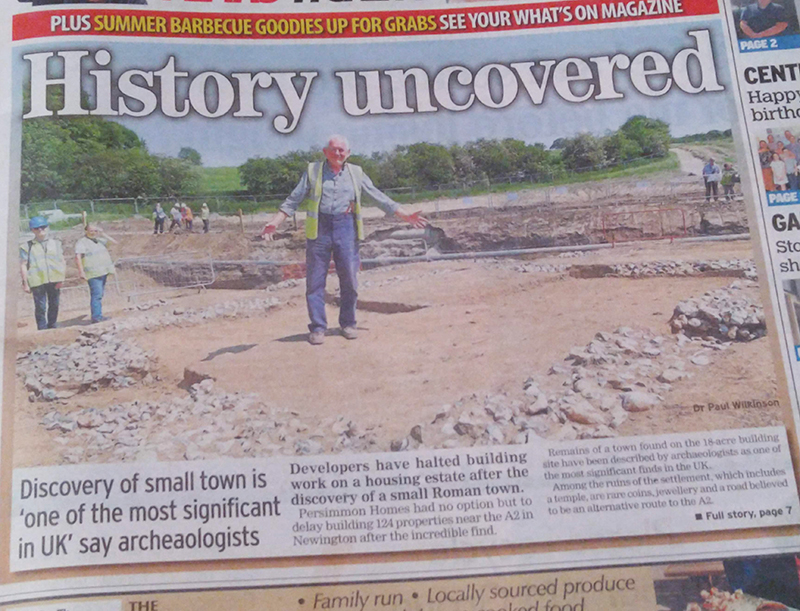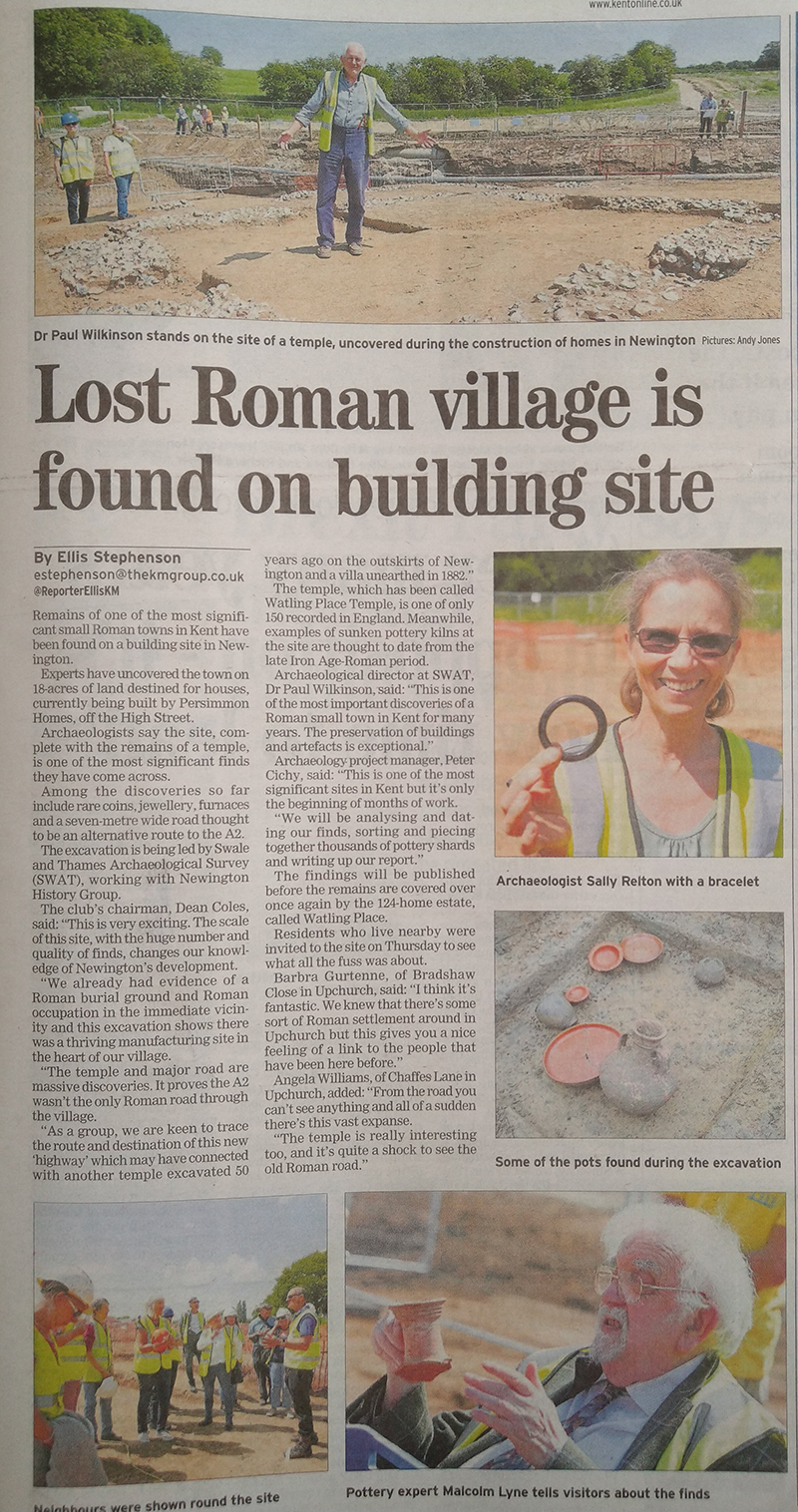
SWAT Archaeology Newsroom
|
4th July 2019 - Temple and ‘highway’ at centre of major Iron Age and Roman find in KentArchaeologists have uncovered major late Iron Age and Roman settlements in an exceptional state of preservation on a construction site alongside the A2 in Newington village, near Sittingbourne.They say the importance of the excavated Roman small town makes it “one of the most significant sites” in Kent and of national importance. They describe some of the finds as “amazing”. Housing is due to cover the 18 acres of farmland, but a team of more than 30 archaeologists has been working full-time on the site for the past eight months. Today (Thursday) they reveal their findings which may re-write our history of this area. The excavations by Swale and Thames Archaeological Survey (SWAT Archaeology) have unearthed a Romano-Celtic temple bounded by a seven-metre wide ‘highway’ that appears to pre-date and take an alternative route to Watling Street (the A2) – the road traditionally considered to be the main Roman transport route between the Kent coast and London. The rarity of Roman temples in England – only some 150 sites are recorded – means that all Romano-Celtic temples with surviving archaeological potential are considered to be of national importance. They contribute to the complete picture of Roman religious practice, including its continuity from the Iron Age. Dr Paul Wilkinson, archaeological director at SWAT Archaeology, today said: “This is one of the most important discoveries of a Roman small town in Kent for many years with the preservation of Roman buildings and artefacts exceptional.” 
Rare iron furnaces and sunken pottery kilns from the late Iron Age-Roman period have been found in situ and several tons of pots, pottery sherds, jewellery and coins have been removed. The excavations can be made public now that all the artefacts have been collected and the site’s features recorded. The most treasured coins discovered are a gold Celtic stater of King Dubnovellanus (c.30-10BC) of the Trinovantes and Catuvellauni Celtic tribes of pre-Roman Britain, a silver denarius of Augustus (27BC-14AD), a cast Syrian glass, a Whitby jet child’s bracelet (c.1-2AD) and other jewellery items. Expensive imported wares indicate the high status of occupants of this land. The experts are excited by the find of a carefully crafted inlay panel, probably for a piece of furniture. This delicate artefact was made of bone and carved into a shape called ‘lunate’ (crescent). It dates to mid and late Roman period. The experts say it is “quite amazing that it has survived almost intact”. Peter Cichy, the project manager at SWAT Archaeology, said: “This is one of the most significant sites in Kent. But it’s only the beginning of months and months of work. We will be analysing and dating our finds, sorting and piecing together thousands of pottery sherds, and writing up our report.” Malcolm Lyne, an internationally renowned Roman pottery expert, has visited the site several times to examine finds. He has identified and estimated the date of many of items, much of it locally-made and some virtually intact. The archaeologists are expected to remain on site for another month. Then the excavations will be covered to enable completion of the 124 dwellings estate. The rarer coins, jewellery and pottery will be displayed in museums and a decision will be taken about the hoard of remaining items after they have been fully catalogued. More than two tons of pottery has been removed from the land. The Newington construction site is owned by Persimmon Homes which delayed construction and financed the archaeological excavations that began last September. It has named the development Watling Place and, as a result, archaeologists are calling the temple Watling Place Temple. Dean Coles, chairman of Newington History Group, which has been liaising with SWAT Archaeology during the dig, said: “This is very exciting. The scale of this site, with the huge number and quality of its finds, changes our knowledge of Newington’s development. “We already had evidence of a Roman burial ground and Roman occupation in the immediate vicinity and this excavation shows there was a thriving manufacturing site in the heart of our village. “The temple and major road are massive discoveries. It proves that the A2 wasn’t the only Roman road through the village. As a history group, we are keen to trace the route and destination of this new ‘highway’ which may have connected with another temple excavated 50 years ago on the outskirts of Newington and a villa unearthed in 1882.” Thousands of urns have been discovered over at least 400 years in a neighbouring field east of Watling Place. It was recorded as being a Roman cemetery. Edward Hasted, the 18th century historian, believed that Newington was the site of the Roman station Durolevum. Martin Crick, sales director for Persimmon Homes South East, said: “It is incredibly exciting to think that when our customers move into their new homes later this year, they will be continuing a tradition of residency on this land that started thousands of years ago. “It has been a privilege for us to see the archaeologists at work on site, and to know that Watling Place now has its own important place in history.” 
21st October 2017 - Deadman's Island reveals the grisly history of KentIt is the island which has inspired tales of supernatural devil dogs and bodies buried without skulls. Now, thanks to erosion, the real history of Deadman's Island off Kent's north coast is being exposed. More than two centuries ago, the island, which lies opposite the Isle of Sheppey, was used as a burial ground for convicts who died on floating prisons, known as prison hulks. Coffins and bones can now be found sticking out of the mud.Please use the link below to download the full report. CLICK HERE to view the full video on BBC website 
7th September 2016 - Preliminary Notes on Two Seasons of Research at Oplontis B (2014-2015)The report on the Preliminary Notes on Two Seasons of Research at Oplontis B during 2014 and 2015. Printed in the Journal of Fasti Online (ISSN 1828-3179), and published by the Associazione Internazionale di Archeologia Classica. Please use the link below to download the full report.CLICK HERE to download the article and read more.
27th February 2015 - KAFS in Dover ExpressA SAXON skeleton, Bronze Age urns and Roman domestic objects were unearthed during a dramatic excavation in Aylesham last week. The discoveries, some of which are likely to date back more than 2,000 years, were made by archaeologists on the building site of the Aylesham expansion development. A well-preserved skeleton thought to be from the Saxon era – therefore up to 1,500 years old – was lifted from an ancient burial ground by experts...CLICK HERE to download the article and read more. 14th January 2015 - KAFS Oplontis Trip 2015Join us in 2015 digging at the Roman Palace at Oplontis, near Pompeii. We have two weeks on site. First week Monday 1st June to Friday 5th June and the second week 8th June to the 12th. Fees are £175 a week.CLICK HERE for further information on joining us for this unique opportunity. 5th January 2015 - Publication of Oplontis Villa A, Volume OneRecently announced is the publication of Oplontis Villa A (“of Poppaea”) at Torre Annunziata, Italy. Volume 1. The Ancient Setting and Modern Rediscovery. It is a born-digital, Open Access book, published by the American Council of Learned Societies, New York. Below is a link to the publication.http://humanities-ebook.blogspot.it/2014/12/new-on-heb-oplontis-villa-of-poppaea-at.html 16th November 2014 - New SWAT News page launched!We have launched our new pages on the SWAT site for ease of navigation, and to include a news page to keep our visitors up to date with our latest endeavours. If you have anything that you feel would be of interest, please contact us at [email protected]
|